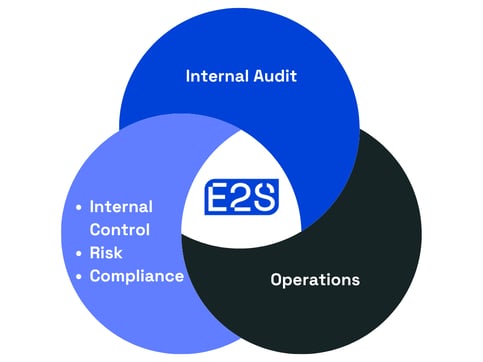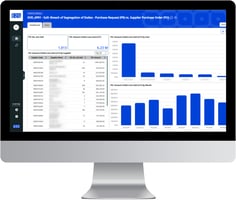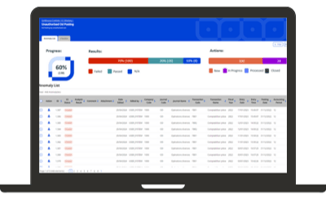As many other fields, Internal audit is experiencing a profound digital transformation that's...
Three Lines of Defense: How a Unified Data Platform Strengthens Risk Governance
Transforming Collaboration Across the Three Lines of Defense Model
In most organizations, a familiar pattern occurs: internal audit, internal control, risk management, and operations work from different versions of the same reality.
Each function extracts its own data, its own tools, builds its own dashboards, and defines its own metrics. Reports pile up, information requests multiply, yet the big picture remains fragmented.
Resulting potentially into? Duplicated efforts, conflicting analyses, misaligned priorities, and growing struggles to meet regulatory demands and board expectations.
The question isn't whether each line of defense does its job well. It's how to get all this expertise working together on a common foundation to create real value.
Understanding the Three Lines of Defense Model (3LOD)
The Three Lines of Defense model, promoted by the Institute of Internal Auditors (IIA), clearly defines who does what:
First line of defense – Operations: They own and manage risk day-to-day, designing, operating, and implementing controls across their activities (purchasing, sales, production, accounting).
Second line of defense – Risk Management, Compliance, and Internal Control: They build the frameworks, policies, and tools, oversee implementation, and ensure risk management and compliance systems work as intended.
Third line of defense – Internal Audit: Reporting to the highest governance level, they provide independent assurance on how well the entire governance and risk management system performs.
The IIA updated this framework in 2020 and 2024 as the "Three Lines Model" to emphasize collaboration over silos, real-time information sharing, smart use of technology as a common working platform, and value creation beyond mere compliance.
This evolution reflects a simple truth: the three lines of defense work better together than apart.
What Are the Common Challenges in the Three Lines of Defense Framework
Without a common data foundation, each function reinvents the wheel:
- Operations spend endless hours responding to repetitive requests from other lines of defense
- Internal control teams drown in thousands of emails justifying anomalies, a never-ending search
- Risk management builds risk maps from interviews and qualitative data instead of enriching them with real, quantified risk indicators (KRI)
- Compliance functions depend on other departments for the data they need
- Internal audit departments re-collect data without visibility into anomalies that were already flagged by the second line, making continuous audit nearly impossible
This creates what Deloitte calls "audit fatigue"—operations spend more time answering requests than running the business.
The hidden cost? Hundreds of hours extracting, processing, and reconciling the same data, with definitions that vary by team.
The strategic impact? Without a consolidated view, it's hard to know which location carries the most risk, which processes need fixing, or whether audit recommendations are actually being implemented.
Unified Data Platform: The Solution for Strengthening Your Three Lines of Defense
How a Collaborative Platform Works
A platform like Eye2Scan serves as a central data hub for your three lines of defense, continuously syncing with ERP systems and giving each line the right level of access. 
The concept is straightforward:
- Single ERPs connection: Data syncs automatically at your chosen frequency—no manual work
- Standardized controls: The same rules apply across all entities
- Continuous monitoring: Anomalies are flagged with each sync
- Instant visibility: Everyone sees the same metrics and can track actions and justifications
- Complete audit trail: Every finding, action, and log is preserved
Uniting All Three Lines of Defense with a Single Source of Truth
First Line of Defense: Real-Time Operational Controls
Operations spot and fix issues before auditors or controllers find them. They get dashboards showing:
- Orders waiting approval beyond threshold
- Mismatches between purchase orders, receipts, and invoices
- New suppliers added to their scope
- Unusual inventory movements
- Invoices pending reconciliation
The value? True "assurance by design"—they fix problems immediately, improve processes proactively, and answer to internal audit & control questions with facts.
Second Line of Defense: Consolidated Risk Management and Compliance Oversight
Risk management, compliance, and internal control teams stop working from periodic extracts and start working from a near-real-time consolidated view:
- Anomaly trends over time
- Continuous monitoring of key controls
- Auto-calculated KRIs (Key Risk Indicators) for each entity and process
- Risk matrix that updates itself
- Cross-entity benchmarking to spot outliers
- Action plan tracking with full transparency
- Workflow-driven anomaly resolution involving operations
The value? They prioritize based on facts, challenge operations with precision, and prove oversight effectiveness with KPIs. They monitor instead of collecting.
Third Line of Defense: Data-Driven Internal Audit
Internal audit stops spending days preparing data and starts their missions with a complete and current dataset, enabling continuous audit:
- 100% transaction coverage
- Auto-generated random samples focused on high-risk areas identified by the second line
- Tracking of past audit recommendations and follow-through
- Cross-control analysis detecting complex patterns
- Period-over-period and entity-to-entity comparisons
- Centralized supporting docs and audit evidence
The value? Internal audit focuses on analysis and high-impact recommendations, not data gathering. Audit coverage expands without adding headcount. Internal audit shifts from looking backward to looking ahead—providing assurance on what truly matters while advising management on emerging risks and performance opportunities.
Seven Key Benefits of a Shared Three Lines of Defense Platform
1. A Common Language Across All Three Lines
All three lines of defense speak the language of data—same definitions, same scope, same metrics. Discussions focus on action, not arguing over whose numbers are right.
2. Multiplied Efficiency in Risk Management
Every control, analysis, and indicator benefits everyone. No more asking for the same information three times. Shared investment, multiplied value.
3. Objective Risk Prioritization
Decisions about where to focus are driven by current, comparative KRIs—not gut feel or habit. The riskiest entities, processes, and exposures surface automatically.
4. Stronger Audit Trail for Compliance
Every anomaly, recommendation, and corrective action is logged. This traceability matters for regulatory compliance and external audits.
5. Faster Risk Response
Anomalies are caught in weeks, not months or years. Problems get fixed before they escalate.
6. Clear Roles and Responsibilities
Each line of defense keeps its role and independence. The shared platform doesn't blur responsibilities—it enables coordination.
7. Real Value Creation Beyond Compliance
A collaborative platform doesn't just reduce risk—it exposes operational inefficiencies (duplicate vendors, obsolete inventory, workarounds), improves financial performance, and builds stakeholder confidence (board, management, external auditors, investors). Governance becomes a performance driver, not just a compliance checkbox.
Transforming Your Three Lines of Defense Model
The Three Lines of Defense framework remains as relevant as ever—provided it rests on a critical foundation: collaboration enabled by shared data.
The real benefit isn't just operational efficiency. It fundamentally changes what each line of defense does all day.
When compliance checks and risk detection run automatically on unified data, hours previously spent gathering information can shift to higher-value work: performance audits, transformation support, root cause analysis, and strategic advisory to management.
Each line keeps its distinct role—manage, oversee, assure—but now works together from the same facts.
Economic bonus: A shared platform splits costs across functions (audit, internal control, compliance, risk, finance), making investment more accessible and ROI faster.


